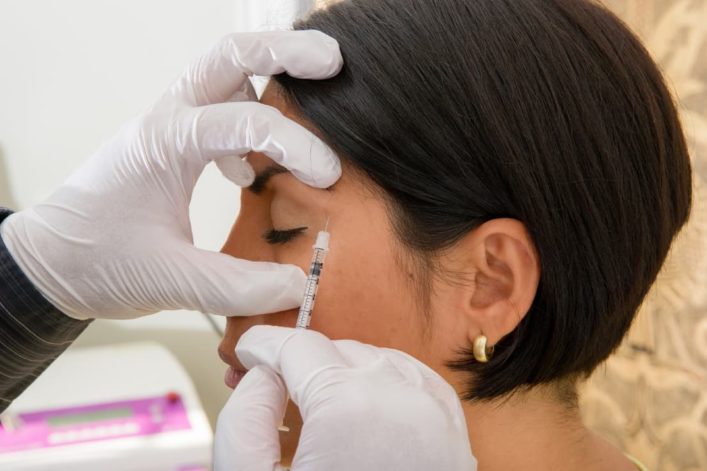How To Become A Botox Nurse: Online Course Training Available
Looking to become a Botox Nurse? Here’s everything you need to know! Botox is a popular treatment for both medical and cosmetic procedures. As a result, there’s a demand for qualified nurses who can administer Botox injections.
I’ll discuss the education and training requirements, as well as the job duties and responsibilities. I’ll also provide you with some tips on how to stand out from the competition when applying for jobs in this field.

So if you are interested in learning more about this exciting and growing profession, keep reading!
This post is for general informational and educational purposes only. You can read the full disclaimer for more information.
What’s Botox anyway
Botox is a drug made from the botulinum toxin. And the toxin comes from the bacteria Clostridium botulinum.
It’s the same toxin that can cause a life-threatening type of food poisoning called botulism. So caution should be taken when handling and administering the drug.
Although Botox was the first to use the botulinum toxin for medical and cosmetic purposes, other companies have since developed their own versions of the drug. Other products on the market include Dysport, Myobloc, and Xeomin (source).
How does Botox work?
Botox is given as an injection and works by weakening or paralyzing certain muscles or by blocking certain nerves. Which makes it ideal for a variety of aesthetic and cosmetic services.
For instance, to treat medical conditions like blepharospasm, Botox can be used to relax the muscles that cause spasms of the eyelids.
In cosmetic procedures, Botox can be used to reduce the appearance of fine lines and wrinkles by temporarily paralyzing the muscles that cause them.
The effects of Botox usually last for three to four months. For some, it may only last two months and for others up to six months. After that, the muscle activity returns, and the wrinkles start to reappear (source).
The procedure can be administered by physicians, physician assistants, dentists, a registered nurse, and other licensed medical professionals.
If you’re unsure whether or not you can administer Botox check with your specific state for their requirements.
Cosmetic nurse vs Aesthetic nurse
Cosmetic nurses are also sometimes called aesthetic nurses. And for the most part, the terms are synonymous. Though there can be some variation in which term is used, where they work, and the duties they perform. However, both can administer Botox injections.
Cosmetic nursing for the most part focuses on dermatological procedures or cosmetic treatments. They work in medical spas, private practices, and dermatology clinics.
They perform cosmetic non surgical procedures procedures like:
- Chemical peels
- Laser hair removal
- Dermal filler
- Botox cosmetic injections
- Microneedling
- Non-invasive body contouring
- IV drips
Cosmetic nurses may see the patient independently, though under the supervision of a medical director.
An aesthetic nurse also called plastic surgical nurses can work in a variety of settings. Places such as plastic surgery clinics, hospitals, dermatology offices, cosmetic surgery centers, and medical spas. You’ll typically see the term aesthetic nurse used for nurses more involved in surgical procedures.
Aesthetic nurses work with plastic surgeons. They assist in aesthetic surgery such as nose reshaping (rhinoplasty), facelift, and removal of fat (liposuction).
They can also perform aesthetic procedures independently but under the supervision of a board-certified physician.
These aesthetic treatments include:
- Polydioxanone (PDO) thread facelifts
- Hair restoration
- Skin rejuvenation using platelet-rich plasma (PRP)
- Botox treatments
- Tattoo removal
- Microdermabrasion
After some years of experience, many aesthetic nurses go on to further their education to become certified aesthetic nurse specialists. Or they may pursue being an aesthetic nurse practitioner to demonstrate their competency in carrying out medical aesthetics.
Remember the terms cosmetic nurse or aesthetic nurse aren’t exclusively used in either setting. And the duties of either can vary depending on the work setting.
How to become a Botox nurse
In order to become a Botox nurse, the first step is to become a registered nurse (RN).
You can become an RN by obtaining a diploma in nursing from an accredited nursing program. Or you can get a two-year associate’s degree in nursing (ADN).
Some students decide to enroll in a bachelor’s degree (BSN) program which takes four years to complete.
Once you’ve completed an accredited nursing program, you’ll need to obtain your RN license. This is done by taking the National Council Licensure Examination for Registered Nurses or nclex-rn exam. Afterward, you can pursue training in aesthetics.
There are many ways to get aesthetic training. You can get a job in a dermatology office, medspa, or plastic surgery office that offers on-the-job training. It’s one of the best ways to start because you’ll make connections and get first-hand experience.
This is essential if you plan to go on and become a Certified Aesthetic Nurse Specialist (CANS) or Certified Plastic Surgical Nurse (CPSN).
When applying to be a certified aesthetic nurse specialist, eligibility requirements are:
- Currently hold an unrestricted RN license
- Have at least 1,000 practice hours within the core specialties in the last 2 years
- Have a minimum of 2 years of experience as an RN working in collaboration with a physician that is Board Certified within one of the following Core specialties: Plastic/Aesthetic Surgery, Ophthalmology, Dermatology, or Facial Plastic Surgery (ENT)
- Have your supervising core physician endorse your application
When applying to be a certified plastic surgical nurse, eligibility requirements are:
- Currently hold an unrestricted RN license
- Have a minimum of 2 years of plastic surgical nursing experience as an RN in a general staff, administrative, teaching, or research capacity for at least 3 years prior to application
- Have spent at least 1,000 practice hours in plastic surgical nursing during 2 of the last 3 years.
- Be currently working in the field of plastic surgical nursing in collaboration with a board-certified plastic surgeon
Fees for both certifications are:
Obtaining a certification does require that you engage in certain activities to maintain your credentials and be eligible for recertification.
A great way to do so is to get involved in the aesthetic or cosmetic nurse world, you can attend conferences and workshops. Or you can join organizations like the International Society of Plastic and Aesthetic Nurses. These are typically weekend events that offer a lot of information and invaluable access to networking with other aesthetic nurses.
Some organizations like The American Association of Aesthetic Medicine and Surgery (AAAMS) also offer an online Botox training course that you can complete at your own pace.
The course will certify you as a Botox nurse aka aesthetic nurse injector, along with a certification in dermal fillers and chemical peels. In a rather short period of time, you can be on your way to making a good income and career out of something you love!
By becoming a Botox nurse, you can enter into this growing field of aesthetic nursing and help people boost their confidence and improve their appearance.
Why you should become a Botox nurse
Both the demand for Botox treatments and the profession of nursing are expected to experience significant growth in the coming years.
The U.S. Bureau of Labor Statistics projects that the employment of registered nurses will grow by 9% from 2020 to 2030.
According to the American Academy of Facial Plastic and Reconstructive Surgery, cosmetic surgery has increased by 10% since the pandemic. This includes both Botox injections and filler treatments. And from 2019, Botox procedures in the US have risen by 54%, according to The Aesthetic Plastic Surgery National Databank.
Not only is there a demand, but you can earn good wages as a botox nurse. The average annual salary for an aesthetic RN is $88,881 per year (source). And the average aesthetic nurse practitioner’s salary in the US is $94,732 (source).
Aesthetic nursing is a great way for RNs to use their skills in order to provide patients with the treatments they desire to look and feel their best.
Tips to land Botox nurse jobs
When applying to become an aesthetic nurse, it is important to highlight any experience you may have in customer service or sales. Aesthetics is a customer service based industry, so employers will be looking for nurses with strong people skills.
It is also important to demonstrate your knowledge of the latest trends in aesthetic treatments. Be sure to mention any continuing education courses you’ve taken or conferences you’ve attended.
Last but not least, be sure to emphasize your passion for helping others look and feel their best. Aesthetics is a field that is all about making people feel good about themselves, so it’s important that your resume reflect your commitment to this goal.
By following these tips, you’ll be sure to stand out from the competition when applying for jobs in the aesthetic nursing field.
How to become a Botox nurse takeaways
- To become a Botox nurse, you must first become a registered nurse and have at least three years of experience.
- You can become certified through organizations like the Plastic Surgical Nursing Certification Board or by taking online courses.
- The demand for both Botox treatments and nursing is expected to grow in the coming years.
- Aesthetic RNs earn an average salary of $88,000.
- Aesthetic nursing is a great way for RNs to use their skills in order to provide patients with the treatments they desire to look and feel their best.
- When applying for jobs in the aesthetic nursing field, it is important to highlight any experience you may have in customer service or sales. You should also demonstrate your knowledge of the latest trends in aesthetic treatments. Last but not least, be sure to emphasize your passion for helping others look and feel their best.
Botox nursing is a growing field with plenty of opportunities for those who are passionate about aesthetics and helping others. By following the tips outlined in this article, you’ll be on your way to a successful career as a Botox nurse in no time.












